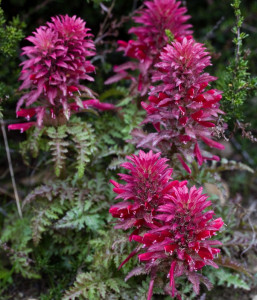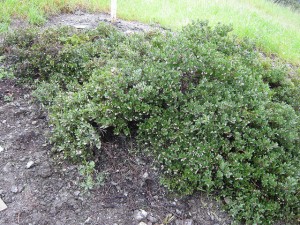What a seemingly simple, but deceptively complex question! Ultimately, perhaps, the least speculative—but not completely satisfactory—answer is that manzanitas inherited this trait from their ancestors. There is compelling evidence that manzanitas (genus Arctostaphylos) are derived from a group of trees, the madrones (genus Arbutus), that have fossils dating as far back as 50 million years. Many madrone species (including our native Pacifc madrone) have smooth, reddish-orange bark. There is strong molecular sequence data and mycorrhizal fungal data showing that madrones were among the earliest members of the heath family (ericaceae), to which manzanita also belongs. Members of this family were probably present during the end of the Cretaceous period, as long as 75 million years ago, an age of great forests, dinosaurs, and, later, mammals, birds, and insects. There must have been considerable selective pressure to minimize herbivory (animal feeders on various plant parts) and perhaps frugivory (animal feeders on fruits and seeds). Most likely, the smooth bark presented an adaptive advantage in these ancient forests, although the nature of that advantage is lost in the mists of time.
Over millions of years, the descendants of madrones radiated into a complex of five shrub genera that includes manzanita, and all but one of which share the smooth bark characteristic.
Smooth bark can also be found on a variety of tree species that come from different flowering plant families, an illustration of convergent evolution (where species from different genetic backgrounds evolve similar traits). Trees with smooth bark lack the standard protection from herbivory afforded by thick, corky exterior bark, so they must have another strategy to protect themselves. In manzanitas and other smooth-bark trees, the bark layer peels away each year. This prevents fungi, parasites, and epiphytes, such as mosses and lichens, from persisting on the tree’s trunk and stems.
According to Sherwin Carlquist, an expert on wood anatomy in California native plants, the rich, reddish coloration of manzanitas—which varies among species from orange to mahogany to dark purple—comes from tannins (and other compounds) manufactured by, and deposited in, the cells of its exterior bark. Tannins are bitter compounds toxic to some organisms; when present in the bark, they most likely serve to deter such organisms (insects, birds, bacteria, etc.) from penetrating the stems and feeding on the tissue within. So the coupling of shedding bark and tannic compounds appears to be an adaptive advantage that discourages stem herbivory.
While discouraging potential munchers, the smooth red bark appears to have the opposite effect on humans: It is almost impossible to resist the urge to caress the smooth, cool, silky red bark of a manzanita as you pass one on the trail. This allure to human touch may not be an adaptive advantage for the tree, but it is certainly one more reason for us to go out into the wonderfully aromatic shrubby wildlands of California, where there are more manzanitas than anywhere else in the world.

.jpg)



-300x199.jpg)